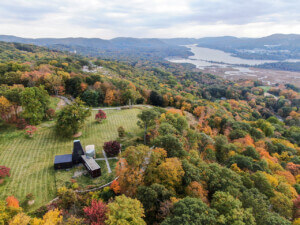Adored by some who consider it a neatly sculpted Modern landscape worthy of protection, and loathed by others who see it as an alienating 1980s byproduct that perpetually falls short in its public duties, Pershing Park conjures up some polarizing perspectives. Located in Northwest D.C. on Pennsylvania Avenue, the park’s condition is shopworn, but its redevelopment continues to divide opinions.
Home to the WWI General John Pershing memorial (a protected monument) Pershing Park was designed in 1981 by landscape architect M. Paul Friedberg. At the time it was a tranquil environment, a welcome contrast to the hectic urban surrounding. Its layout is ordered, and clean lines run through the park, maintaining a harmonious and symmetrical relationship with the water and greenery—at least, that was what was meant to be. Once upon a time, the park promised to be a place to ice-skate in the winter and relax in the summer. The fountain and ice-skating framework however, have been defunct for years.
The water’s serenity and sense of calm is easily disrupted when upkeep is ignored as litter fills the pool and steps become dirty. Paving slabs are riddled with cracks and are uneven, the slick lines now lost. It’s no coincidence that that idyllic images shown on the American Society of Landscape Architects‘s website (via The Cultural Landscape Foundation, TCLF) are clearly dated (though the date of the photographs is unknown).
Now, the World War I Memorial Centennial Commission is eager for change. A competition which the commission ran in 2015 resulted in architect Joseph Weishaar, landscape architect Phoebe McCormick Lickwar and sculptor Sabin Howard winning with their proposal: The Weight of Sacrifice.
The design does away with the water. A problematic feature, seen as a catalyst to the park’s downfall, it is replaced by a lawn that is partially surrounded by 10-foot-high walls that hug the perimeter, using bas-reliefs to inform visitors about WWI.
The aim is to provide more space to relax, but it also sees a change in the park’s role, becoming a place for historical education too. Costs are estimated at $38 million by the commission who has currently raised $6 million in their bid to bring about change.
Change however, may not come so easily. On the other side, those who fight for the parks protection are attempting to place the park on the National Register of Historic Places. If successful, any changes, regardless of money raised, would be significantly curtailed.
It’s not hard to see both sides of the argument. On one hand, to maintain the current style and layout of the park pays respect to the WWI General John Pershing memorial of which it was designed to do. On that note, any change would disrupt the relationship between the park and the memorial. Conversely, the space’s decline surely implies that it is unsuccessful, so much so that none bother to maintain it. For this to be fixed, more need to be welcomed in and more space is needed to facilitate this.
Joe Weishaar argues that the dropped water feature is a “blind spot” and is hence ignored. Sculptor Sabin Howard envisions an “uplifting story of transformation, showing how noble the human race can be.”
While the campaign for change gathers steam, the fight for protection does have some weight in the form of Charles Birnbaum, president and CEO of The Cultural Landscape Foundation (TCLF) and Darwina Neal, former president of ASLA among others. Here, Birnbaum argues for “making some changes, but keeping the signature and character-defining features intact.”
From a withdrawn perspective, one cries out for collaboration between the two parties. Jared Green of The Dirt points out: “Whatever the outcome, one long-term question is: can this park be well-maintained moving forward? If not, we may be back to where we are now 30 years in the future.”










